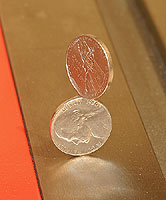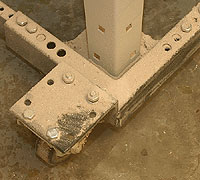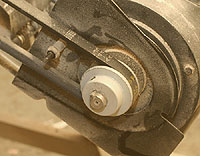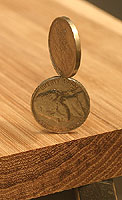This is a Veteran Owned site

 |
Is standing a nickel on edge really telling you how well a table saw works? By that rational, adding a second nickel should make you psychic! Click image to enlarge |
The Nickel Test
Legit or parlor trick?
Text & photos by Tom Hintz
Posted – 12-16-2006
Somewhere along the line, standing a nickel on edge was anointed as a true test of quality in table saws and who knows how many other machines. I have to admit that early on, I spent an inordinate amount of time chasing nickels around my first table saw. What struck me was that despite failing the nickel test miserably, that saw cut wood perfectly. Plus, it didn’t shake or vibrate noticeably though I was convinced it must be because the nickel kept falling over.
Failure Assured
The series of failed nickel tests had me obsessed with finding out why they refused to stand on edge. While investigating my table saw, I discovered a few contributing factors that are likely to be present in your shop as well.
 |
 |
(top) Getting the table surface perfectly level to gravity, (not the shop floor) especially with a mobile base under it, is a chore in itself but necessary for a nickel to have any hopes of standing on edge. |
First, while the surface of my saw was level to the floor it was not perfectly level to the world. Since gravity (and the nickel) cares only about the relationship between the surface on which the nickel is stood and the center of the Earth, the floor is actually a minor player in this. Complicating this further is that our shop floors are rarely level as perceived by gravity, nor are they perfectly flat. That means unless the saw is left in or returned to the same exact spot, the surface must be leveled again. Put a mobile base under the saw and all this gets way more complicated.
The belt that drives the blade on most table saws can also be a problem. The tension that prevents the belt from slipping can also cause the belt to develop a “set” when it is not running, particularly in cooler weather. When that “set” passes over the pulleys, it causes a vibration that can easily destabilize the nickel. Running the saw long enough to warm the belt up usually relieves this set but as it ages, belts can retain some degree of set – and the vibration.
Then there is the nickel itself. During this quest for the truth, I began inspecting the nickels that passed through my life. Like people, not many nickels are perfectly shaped. In addition to being manufactured at the rate of several per second, a nickels life can be filled with bouncing through coin operated mechanisms and against the more dominant quarters that rule pockets. Maybe we should urge the US Mint to issue test-grade nickels.
The Fix Is In?
Let’s say that we level the table to the world/gravity perfectly, adjusting all four legs so they are firmly in contact with the floor at the same time. We start the saw and the nickel stands on edge! Cool! Does that mean the saw will cut better? Nope.
All the nickel test tells us is that nothing is bent or way out of balance. A stable nickel has nothing to do with the alignments that make a saw cut square and clean. The nearly imperceptible level of vibration necessary to knock the nickel over has nothing to do with cut quality either. If a vibration is severe enough to impact cut quality, we won’t need the nickel test to learn that.
What’s the Point?
 |
This saw also fails the "Nickel Test" every time, but cuts wood like a dream and has no vibrations that can be felt in the table or any of the controls. Click image to enlarge |
Exactly why the nickel test is so important to some folks escapes me. Nobody argues that a serious vibration is a good thing in any machine. However, the nearly nonexistent shimmy necessary to topple an imperfect nickel has no value in determining if a saw is good or not. Yet, people do just that.
In the end, I took solace in the fact that despite repeatedly failing the nickel test, my saw cut wood square, true and cleanly. It also didn’t shake, shimmy or vibrate enough to feel. Practical experience tells me the nickel test is a parlor trick and useful for determining a saws worth only to the big thinkers that make up a small but vocal portion of the woodworking community.
Have a comment on this story? - Email Me!
All written, photographic and drawn materials are property of and copyright by NewWoodworker.com LLC 2000-2019. Materials may not be used in any way without the written permission of the owner.
